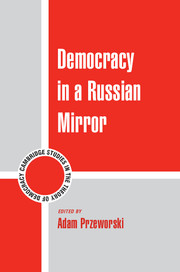Book contents
- Frontmatter
- Contents
- Contributors
- Introduction
- PART I RUSSIA
- 1 Peculiarities of Russian Politics
- 2 Imitating Democracy, Feigning Capacity
- 3 Russian Perspectives on Democracy, Political Emancipation, and Integrity
- 4 Color Revolutions and Russia
- PART II DEMOCRACY IN A RUSSIAN MIRROR
- PART III PATHS OF POLITICAL CHANGE
- Afterword: Open Issues and Disagreements
- References
- Name Index
- Subject Index
4 - Color Revolutions and Russia
from PART I - RUSSIA
Published online by Cambridge University Press: 05 June 2015
- Frontmatter
- Contents
- Contributors
- Introduction
- PART I RUSSIA
- 1 Peculiarities of Russian Politics
- 2 Imitating Democracy, Feigning Capacity
- 3 Russian Perspectives on Democracy, Political Emancipation, and Integrity
- 4 Color Revolutions and Russia
- PART II DEMOCRACY IN A RUSSIAN MIRROR
- PART III PATHS OF POLITICAL CHANGE
- Afterword: Open Issues and Disagreements
- References
- Name Index
- Subject Index
Summary
INTRODUCTION
“Color revolution” is an ambiguous term in Russian as well as English. Its meaning is difficult to pin down, and so is the nature of the upheavals that, between 2003 and 2010, convulsed Georgia, Ukraine, Kyrgyzstan, Moldova, and Kyrgyzstan. Were these color revolutions a second wave of the “velvet revolutions” that accompanied the fall of Communism in 1989? Or did they represent something new, a distinct type of revolution specific to post-Soviet space (or post-Communist space, if we include Serbia in 2000)? Or were the color revolutions, as the Russian propaganda machine alleges, inspired from abroad and directed against legitimate authorities in sovereign states and, indirectly, against Russia itself?
The real or imaginary involvement of the West in the color revolutions is the main reason why Russian officials adamantly deny the revolutionary character of these events and classify them, instead, as mere coups. In Kyrgyzstan, no Western involvement could be proved in either the Tulip Revolution that overthrew President Askar Akayev in March 2005 or in the events of April–June 2010 that resulted in the ouster of President Kurmanbek Bakiyev. Nor did anti-Russian motives play a significant role. Nevertheless, in the first case, Russian propaganda easily found a way to concoct a story line involving both outside interference and an anti-Moscow plot. A local “mafia,” allegedly associated with foreign forces, became a substitute for “the West,” and the pro-Russian character of the new regime was declared to be a “victory for healthy forces” over the “conspirators.” In April 2010, by contrast, the Russian mass media dropped all mention of foreign influence from its interpretation of the Kyrgyz events, focusing exclusively on the domestic factors that unleashed the mayhem.
From a scholarly perspective, in any case, the question of the nature of the color revolutions remains wide open.
WERE THERE ANY REVOLUTIONS?
Those who lose by a revolution are rarely inclined to call it by its real name.
– Leon TrotskyIronically, official Russian criticism of the so-called color revolutions is explicitly or implicitly based on the traditional Marxist definition of social revolution.
- Type
- Chapter
- Information
- Democracy in a Russian Mirror , pp. 78 - 94Publisher: Cambridge University PressPrint publication year: 2015
- 1
- Cited by



